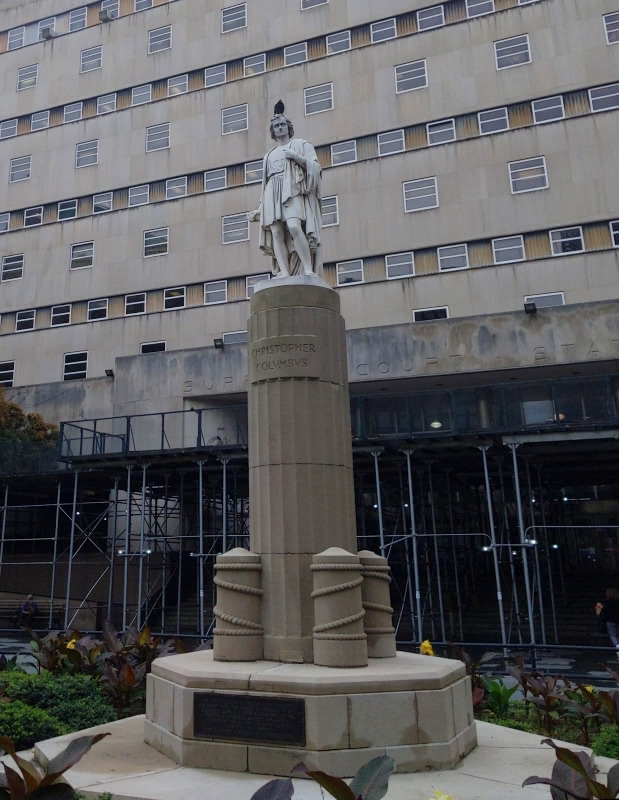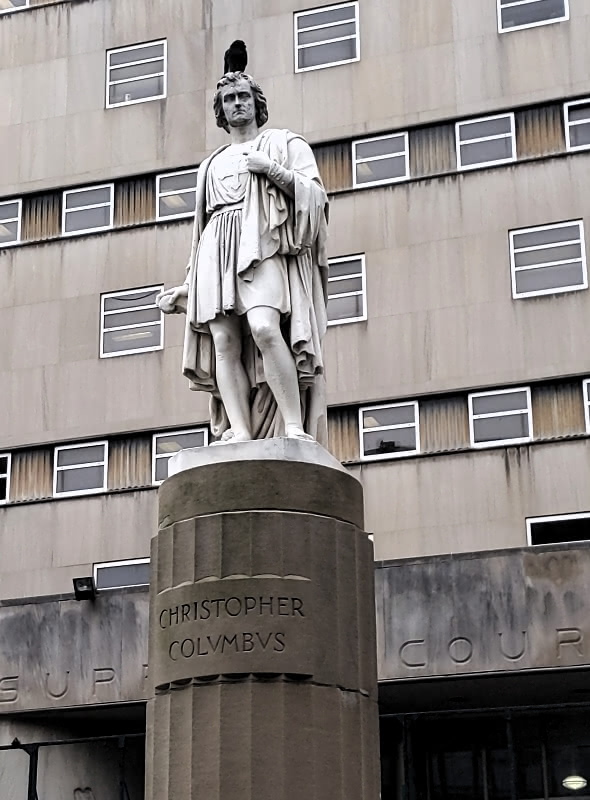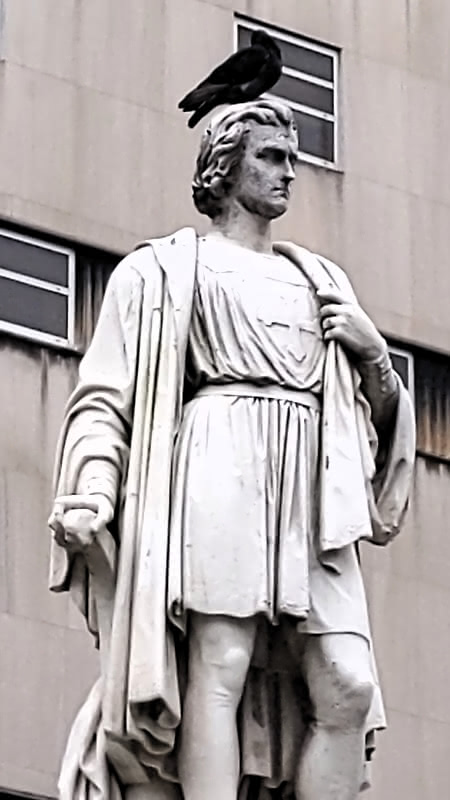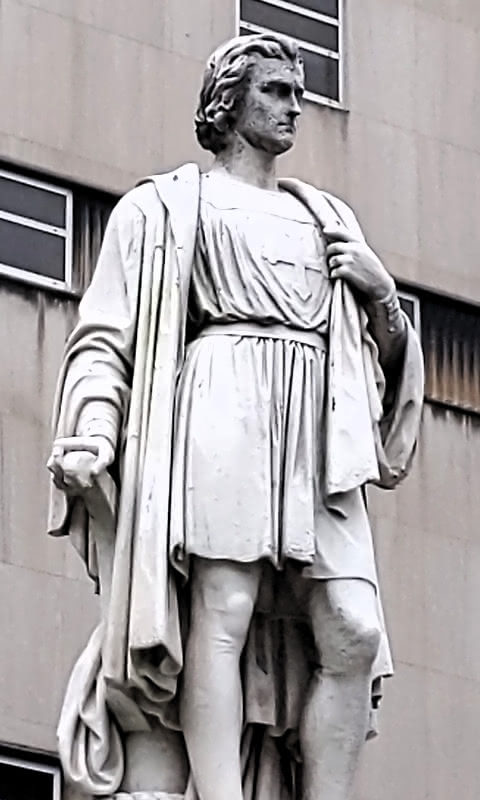New York City was hit by a wave of protests and riots in June 2020, some of which were encouraged by state authorities notwithstanding their having otherwise advised everyone to social distance. Then, these same officials imposed a curfew as a result of the civic disorder that was largely not applied to those who were causing the disorder. Many of them crossed into Brooklyn using the Manhattan and Brooklyn Bridges. Not too far off the exits of the Bridges stands a proud statue of Christopher Columbus in front of the Soviet-esque New York State Supreme Court Building, which itself is just a bit more than a stone’s throw from Brooklyn Borough Hall. One of the enduring mysteries of New York City is that the statue somehow went unscathed (to the best of my knowledge) from the events of June 2020, notwithstanding that Columbus is not known to be a popular figure with the crowds of June 2020 (many store and bank windows, not to mention merchandise, were less fortunate than good ‘ole Columbus). Today marks the 2023 edition of Columbus Day, and while I cannot explain how the Borough Hall Columbus has held up so well, I am glad that it continues to stand proud in the midst of our omnipresent one-sided statue wars and increasing instances of graffiti and vandalism (poor Theodore Roosevelt was less fortunate at the Museum of Natural History that he contributed much to). On August 25, 2023, I noted a curious site on top of our dignified Columbus.
Did the great explorer obtain a fun hat on his travels or is that something else?
On closer inspection, Columbus appears to have a visitor from the Columbidae family.
That, my friends, is a pigeon. I note that this scene is less than five minutes away from where I assisted my New Leaf Journal colleague Victor V. Gurbo in a storied pigeon rescue. The greater Borough Hall area is popular with our feathered friends.
The pigeon was gracious enough to hang around for my photo shoot. But pigeons, like 15th century explorers, are often restless, so the pigeon vacated its perch after I was done capturing the scene.
I knew when I took the Columbus-Columbidae photos that I would publish them on Columbus Day. I noted that the statue has a dedication tablet and figured that some readers would be curious what was on it.

THE COOPERATION OF MAYOR JOHN V. LINDSAY AND ADMINISTRATOR AUGUST HECKSCHER OF P.R.C.A. ENABLED JOHN N. LACORTE FOUNDER OF THE ITALIAN HISTORICAL SOCIETY OF AMERICA TO ENRICH THE BROOKLYN CIVIC CENTER WITH THIS MONUMENT INSTALLED BY A. OTTAVINO, OCTOBER 8, 1971
See New York City Parks Department page.
Below, I offer brief information about the figures listed on the tablet.
- John Lindsay (1921-2000) was the 103rd Mayor of New York City, serving from 1966 to 1973 and covering the installation of the Columbus statue.
- August Heckscher (1914-1997) was a journalist who served as Parks Commissioner from 1967-1972 during the Lindsay administration.
- John N. Lacorte (see also) was the founder of the Italian Historical Society of America and the leader of the movement to make Columbus Day a national holiday.
- I believe that A. Ottavino refers to the A. Ottavino Corp., which most likely provided some of the stone for the statue base and helped with the installation.
The New York City Parks Department provides additional information about Columbus Park and the statute. Here, we learn that the Columbus statue itself is quite a bit older than one would think from having read the dedication tablet.
This sculpture has been described as representing the navigator ‘standing upon the deck of a ship alone…before the West Continent burst into view,’ ship’s tiller in hand, as his ‘mutinous crew have all deserted him.’ Emma Stebbins (1815–1882) carved this colossal marble sculpture in the late 1860s. She was one of several female expatriate artists living in Rome at the time whom author Henry James dubbed ‘the white marmoreal flock.’ The sister of Park Board President Henry Stebbins, she is best known for creating the bronze statue of the Angel of the Waters at the center of Central Park’s Bethesda Fountain.
Emma Stebbins (1815-1882) is best known for The Angel of the Waters sculpture in Manhattan’s Central Park. You can find a gentle introduction to her work here. Henry Stebbins (1811-1881) was Emma Stebbins’ brother and the head of the Central Park Conservatory at the time of the installation of The Angel of the Waters. He had previously served one term in Congress and been a successful businessman.
The statute was carved more than 100 years before it found a place of honor. But how did it find its way to what is now Columbus Park near Brooklyn Borough Hall?
Merchant and art patron Marshall O. Roberts presented this statue to the Board of Commissioners of Central Park in 1869, but they did not choose to install it. In 1934, it was discovered stored in the 97th Street maintenance yard in Central Park. Parks’s chief consulting architect Aymar Embury II (1880–1966) designed a new stylized limestone pedestal consisting of a fluted column on an octagonal base, and the statue was installed that year in Columbus Park (formerly Mulberry Bend Park) in Chinatown. In 1971, following the renaming of the southern part of Cadman Plaza in Brooklyn in honor of Columbus, the statue was moved to its current location in front of the New York State Supreme Court Building.
You can learn about Marshall Owen Roberts (1813-1880) on a Metropolitan Museum of Art page about a bust of his in its collection. Aymar Embury (1880-1966) was a renowned architect. He died a five years before the base and column he designed for the statue was moved from Manhattan to Brooklyn.
From the very good park resource, we learn that the Columbus statue had a long history. It was originally designed for Central Park but was not installed there. The statue was rescued from obscurity in 1934 and installed in Manhattan’s Chinatown. It was only in 1971 that the statue was moved across the Bridge to Brooklyn’s new Columbus Park it Cadman Plaza.
The official page for the monument notes that it is constructed from Italian marble and limestone. Columbus himself stands 7 feet tall while the statue base is 11 feet tall (12 feet counting the base).
Thanks to Columbus Day and a pigeon, we unraveled the history and backstory of one of Brooklyn’s more aesthetic statues.




